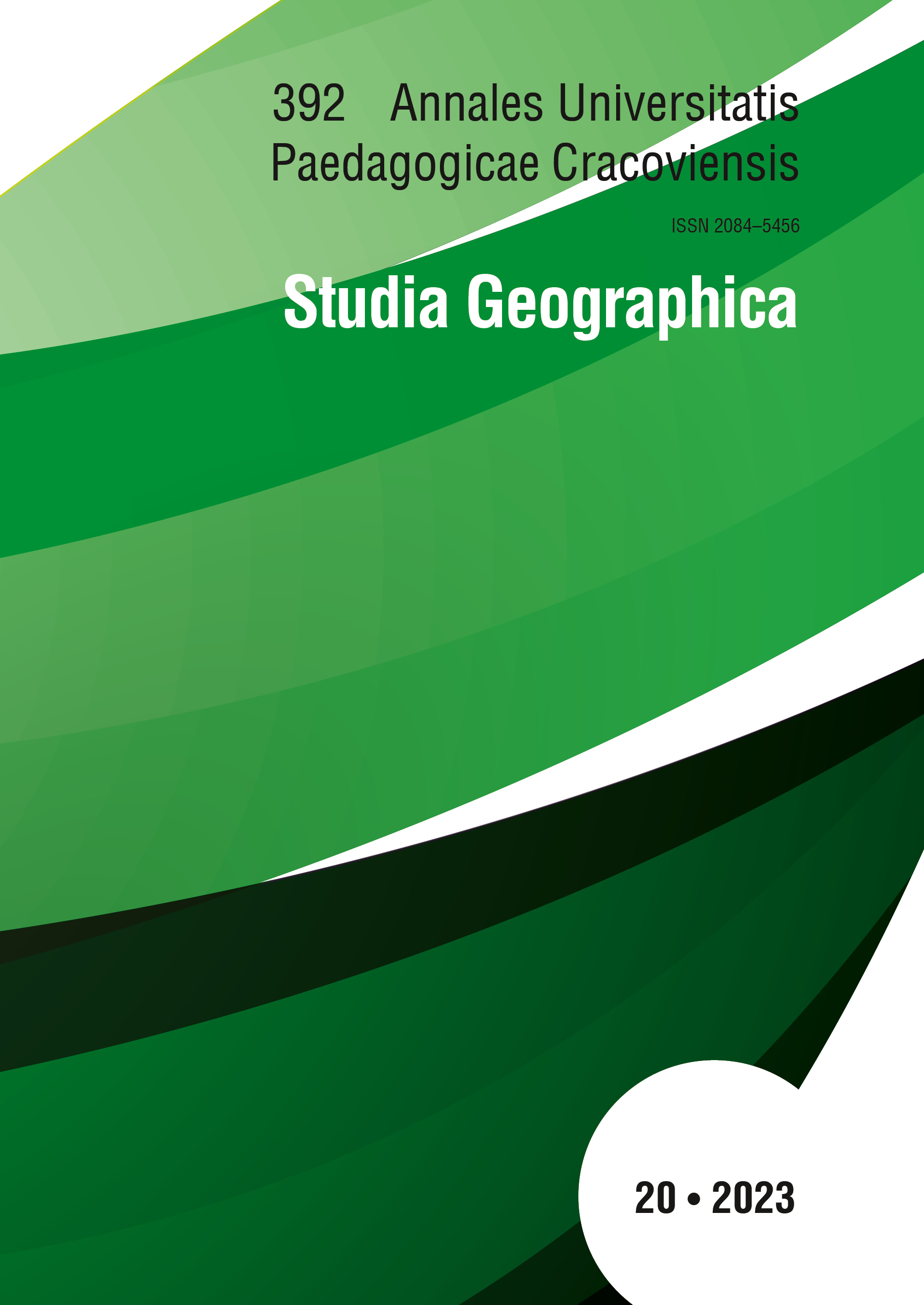Environmental diagnostic of municipality of zinacantepec, Estado de México
DOI:
https://doi.org/10.24917/20845456.20.3Słowa kluczowe:
diagnostyka, SGT, ewolucja środowiska psychologicznego, wielodyscyplinarność, skażenieAbstrakt
In the period 2021‑ 2023, technical tours were conducted as part of the Local Ecological Management of Zinacantepec to carry out the environmental diagnosis of the territory, in which soil degradation is present in the sub‑ b asin of the Tejalpa River while the forest ecosystem in the Zinacantépetl Formation is in a process of feedback according to the General System Theory (GST), that is, recovery with a positive trend in the forest cover. The purpose of this research is to analyze the characteristics of the physical‑ g eographical subsystem
in order to determine the environmental conditions in the study area. In order to achieve the specific objectives, a methodology based on the evaluation of the disturbances in the balance of the environmental system was proposed, for which thematic cartography was obtained, as well as the state of evolution of the relief by means of matrices applied in field work. On the other hand, through COMPROBIDES, training sessions and working groups have been held to present multidisciplinary proposals that promote environmental protection based on the results obtained, in which processes of land use change, water erosion, deforestation, greenhouse gas emissions, water pollution and urban location in agricultural areas have been identified. It should be noted that knowledge of the geodynamics of geographic space has contributed to social and public participation for the preservation of natural resources.
Bibliografia
Arce, J., Macías, J., & Vázquez‑ S elem, L. (2003). The 10.5 ka Plinian eruption of Nevado de Toluca volcano, Mexico: Stratigraphy and hazard implications. Geological Society of America Bulletin, 230–248.
Bernal Lima, A. (2022). Peligros por inundación y remoción en masa en el municipio de Zinacantepec. Toluca, Estado de México, Universidad Autónoma del Estado de México: TESIS Para obtener el Título de Licenciado en Geografía, .
CC. Diputados Secretarios De La H. LIV Legislatura;. (2001). Libro Quinto, Del Ordenamiento Territorial de los Asentamientos Humanos y del Desarrollo Urbano de los Centros de Población. En C.D. Legislatura, Código Administrativo Del Estado De México (págs. 91–171). Toluca de Lerdo, México.
CONANP. (2019). Términos De Referencia Para La Elaboración De Programas De Manejo De Las Áreas Naturales Protegidas. SEMARNAT.
Espinosa Rodríguez, L. M., Balderas Plata, M. Á., & Baro Suárez, J. E. (2018). El relieve, factor para la génesis, desarrollo y gestión del riesgo. Ciencia Ergo, XXV. Obtenido de https://www.redalyc.org/articulo.oa?id=10453975008
Espinosa Rodríguez, L. M., Balderas‑ P lata, M. Á., & Cabadas‑ B áez, H. V. (2014). Caracterización Geomorfológica Del Área Natural Protegida Nevado de Toluca: Complejo de Volcanes Nevado De Toluca y San Antonio. Biología y Química, Área I. Físico Matemáticas
y Ciencias de la Tierra, 6–14.
FAO. (2015). Objetivos de Desarrollo Sostenible . Obtenido de La FAO y el post 2015: http://www.fao.org/sustainable‑ d evelopment‑ g oals/overview/fao‑ a nd‑ p ost‑2015/es/
Galicia, L., García‑R omero, A., Gómez‑ M endoza, L., & Ramírez, M. (2007). Cambio de uso del suelo y degradación ambiental. Ciencia, 50–59.
INEGI. (2009). Guía para la interpretación de cartografía uso del suelo y vegetación, escala 1:250, 000. México: Serie III de información de Uso del Suelo y Vegetación.
INEGI. (2020). Censo de Población y Vivienda. México.
INEGI. (2020). Marco Geosestadístico Nacional. México.
Lugo Hubp, J. (2011). Diccionario geomorfológico. Instituto de Geografía | Universidad Nacional Autónoma de México, Geografía para el siglo XXI (Obra general) Serie Textos universitarios, 335.
Mooser, F., Montiel, A., & Zúñiga, A. (1996). Nuevo mapa geológico de las cuencas de México, Toluca y Puebla : estratigrafía, tectónica regional y aspectos geotérmicos. México: Comisión Federal de Electricidad (CFE).
OEA. Departamento de Desarrollo Regional y Medio Ambiente. Secretaría Ejecutiva para Asuntos Económicos y Sociales. (1993). Manual sobre el manejo de peligros naturales en la planificación para el desarrollo regional integrado. USAID. Obtenido de http://www.oas.org/dsd/publications/unit/oea65s/oea65s.pdf
ONU. (2001). El ordenamiento territorial como opción de políticas urbanas y regionales en América Latina y el Caribe. CEPAL – SERIE Medio ambiente y desarrollo.
Ordaz Hernández, A., Espinosa Rodríguez, L. M., Hernández Santana, J. R., & Expósito Castillo, J. L. (2018). Riesgo por procesos de vertientes y otros movimientos del terreno. En J.E. Baró Suárez, & F. Monroy Gaytán, Enfrentando los riesgos socionaturales.
CONACYT, Registro Nacional de Instituciones y Empresas Cientificas y Tecnologicas.
Reyes Enríquez, A., Valdéz Pérez, M. E., & Mireles Lezama, P. (2007). Geomorfología del Parque Nacional Nevado de Toluca. Regionalidad y localidad en la Globalización, Varsovia, Edit. Obtenido de http://observatoriogeograficoamericalatina.org.mx/
egal11/Procesosambientales/Geomorfologia/02.pdf
SEMARNAT. (2012). Guía para la Elaboración de Planes de Acción Climática Municipal (PACMUN). México: ICLEI, Embajada Británica en México.
Tarbuck, E. J., & Lutgens, F. K. (2005). Ciencias de la Tierra. Una introducción a la Geología Física. Madrid: Pearson Educación S.A.
WRB. (2015). Base referencial mundial del recurso suelo 2014, Actualización 2015. Sistema internacional de clasificación de suelos para la nomenclatura de suelos y la creación de leyendas de mapas de suelos. Informes sobre recursos mundiales de suelos 106. Roma: FAO.
Young Medina, M. A., & Yong Medina, J. E. (2011). Ecología y medio ambiente. Nueva Imagen S.A. de C.V.
Pobrania
Opublikowane
Numer
Dział
Licencja
Prawa autorskie (c) 2024 Annales Universitatis Paedagogicae Cracoviensis Studia Geographica

Utwór dostępny jest na licencji Creative Commons Uznanie autorstwa – Bez utworów zależnych 4.0 Międzynarodowe.
Złożenie artykułu do druku oznacza wyrażenie zgody na bezpłatne (tj. bez honorariów autorskich) przeniesienie autorskich praw majątkowych na Wydawcę i zezwolenie na wydanie pracy w postaci drukowanej w dowolnej liczbie egzemplarzy oraz zamieszczenie jej w postaci otwartego dostępu na stronie internetowej czasopisma, w bibliotekach cyfrowych oraz innych cyfrowych platformach wydawniczych, z którymi Wydawca zawarł lub zawrze stosowne porozumienie o udostępnianiu. W przypadku artykułów wieloautorskich przyjmuje się, że autor zgłaszający pracę („correspondingauthor”) ma pełnomocnictwo do reprezentowania pozostałych współautorów w tym zakresie. Autorzy są proszeni o podpisanie stosownego oświadczenia w tej sprawie.

